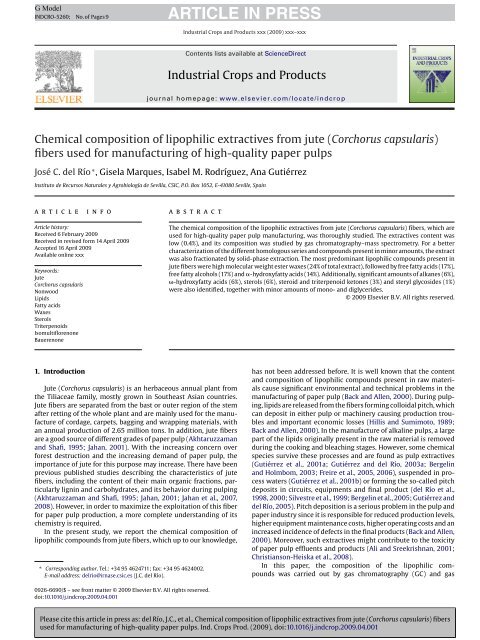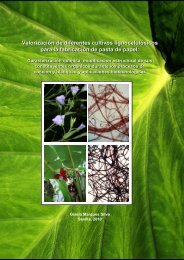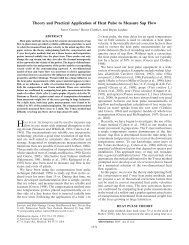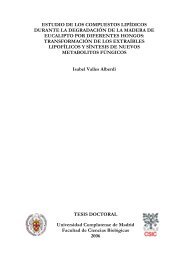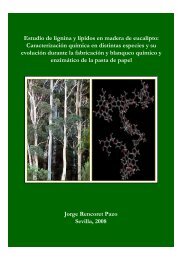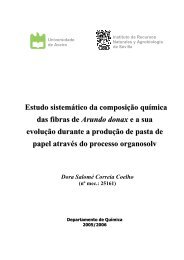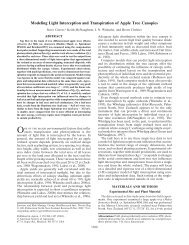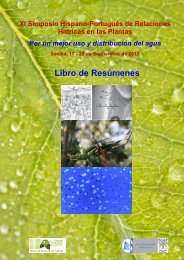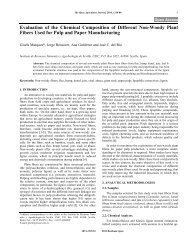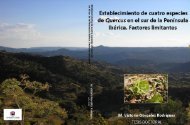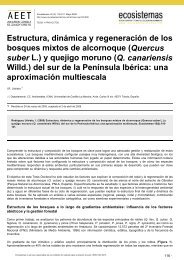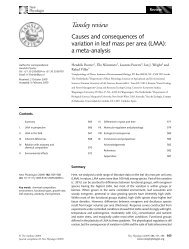Chemical composition of lipophilic extractives from jute (Corchorus ...
Chemical composition of lipophilic extractives from jute (Corchorus ...
Chemical composition of lipophilic extractives from jute (Corchorus ...
Create successful ePaper yourself
Turn your PDF publications into a flip-book with our unique Google optimized e-Paper software.
G Model<br />
INDCRO-5260; No. <strong>of</strong> Pages 9<br />
ARTICLE IN PRESS<br />
Industrial Crops and Products xxx (2009) xxx–xxx<br />
Contents lists available at ScienceDirect<br />
Industrial Crops and Products<br />
journal homepage: www.elsevier.com/locate/indcrop<br />
<strong>Chemical</strong> <strong>composition</strong> <strong>of</strong> <strong>lipophilic</strong> <strong>extractives</strong> <strong>from</strong> <strong>jute</strong> (<strong>Corchorus</strong> capsularis)<br />
fibers used for manufacturing <strong>of</strong> high-quality paper pulps<br />
José C. del Río ∗ , Gisela Marques, Isabel M. Rodríguez, Ana Gutiérrez<br />
Instituto de Recursos Naturales y Agrobiología de Sevilla, CSIC, P.O. Box 1052, E-41080 Seville, Spain<br />
article info<br />
Article history:<br />
Received 6 February 2009<br />
Received in revised form 14 April 2009<br />
Accepted 16 April 2009<br />
Available online xxx<br />
Keywords:<br />
Jute<br />
<strong>Corchorus</strong> capsularis<br />
Nonwood<br />
Lipids<br />
Fatty acids<br />
Waxes<br />
Sterols<br />
Triterpenoids<br />
Isomultiflorenone<br />
Bauerenone<br />
1. Introduction<br />
abstract<br />
Jute (<strong>Corchorus</strong> capsularis) is an herbaceous annual plant <strong>from</strong><br />
the Tiliaceae family, mostly grown in Southeast Asian countries.<br />
Jute fibers are separated <strong>from</strong> the bast or outer region <strong>of</strong> the stem<br />
after retting <strong>of</strong> the whole plant and are mainly used for the manufacture<br />
<strong>of</strong> cordage, carpets, bagging and wrapping materials, with<br />
an annual production <strong>of</strong> 2.65 million tons. In addition, <strong>jute</strong> fibers<br />
are a good source <strong>of</strong> different grades <strong>of</strong> paper pulp (Akhtaruzzaman<br />
and Shafi, 1995; Jahan, 2001). With the increasing concern over<br />
forest destruction and the increasing demand <strong>of</strong> paper pulp, the<br />
importance <strong>of</strong> <strong>jute</strong> for this purpose may increase. There have been<br />
previous published studies describing the characteristics <strong>of</strong> <strong>jute</strong><br />
fibers, including the content <strong>of</strong> their main organic fractions, particularly<br />
lignin and carbohydrates, and its behavior during pulping<br />
(Akhtaruzzaman and Shafi, 1995; Jahan, 2001; Jahan et al., 2007,<br />
2008). However, in order to maximize the exploitation <strong>of</strong> this fiber<br />
for paper pulp production, a more complete understanding <strong>of</strong> its<br />
chemistry is required.<br />
In the present study, we report the chemical <strong>composition</strong> <strong>of</strong><br />
<strong>lipophilic</strong> compounds <strong>from</strong> <strong>jute</strong> fibers, which up to our knowledge,<br />
∗ Corresponding author. Tel.: +34 95 4624711; fax: +34 95 4624002.<br />
E-mail address: delrio@irnase.csic.es (J.C. del Río).<br />
0926-6690/$ – see front matter © 2009 Elsevier B.V. All rights reserved.<br />
doi:10.1016/j.indcrop.2009.04.001<br />
The chemical <strong>composition</strong> <strong>of</strong> the <strong>lipophilic</strong> <strong>extractives</strong> <strong>from</strong> <strong>jute</strong> (<strong>Corchorus</strong> capsularis) fibers, which are<br />
used for high-quality paper pulp manufacturing, was thoroughly studied. The <strong>extractives</strong> content was<br />
low (0.4%), and its <strong>composition</strong> was studied by gas chromatography–mass spectrometry. For a better<br />
characterization <strong>of</strong> the different homologous series and compounds present in minor amounts, the extract<br />
was also fractionated by solid-phase extraction. The most predominant <strong>lipophilic</strong> compounds present in<br />
<strong>jute</strong> fibers were high molecular weight ester waxes (24% <strong>of</strong> total extract), followed by free fatty acids (17%),<br />
free fatty alcohols (17%) and -hydroxyfatty acids (14%). Additionally, significant amounts <strong>of</strong> alkanes (6%),<br />
-hydroxyfatty acids (6%), sterols (6%), steroid and triterpenoid ketones (3%) and steryl glycosides (1%)<br />
were also identified, together with minor amounts <strong>of</strong> mono- and diglycerides.<br />
© 2009 Elsevier B.V. All rights reserved.<br />
has not been addressed before. It is well known that the content<br />
and <strong>composition</strong> <strong>of</strong> <strong>lipophilic</strong> compounds present in raw materials<br />
cause significant environmental and technical problems in the<br />
manufacturing <strong>of</strong> paper pulp (Back and Allen, 2000). During pulping,<br />
lipids are released <strong>from</strong> the fibers forming colloidal pitch, which<br />
can deposit in either pulp or machinery causing production troubles<br />
and important economic losses (Hillis and Sumimoto, 1989;<br />
Back and Allen, 2000). In the manufacture <strong>of</strong> alkaline pulps, a large<br />
part <strong>of</strong> the lipids originally present in the raw material is removed<br />
during the cooking and bleaching stages. However, some chemical<br />
species survive these processes and are found as pulp <strong>extractives</strong><br />
(Gutiérrez et al., 2001a; Gutiérrez and del Río, 2003a; Bergelin<br />
and Holmbom, 2003; Freire et al., 2005, 2006), suspended in process<br />
waters (Gutiérrez et al., 2001b) or forming the so-called pitch<br />
deposits in circuits, equipments and final product (del Río et al.,<br />
1998, 2000; Silvestre et al., 1999; Bergelin et al., 2005; Gutiérrez and<br />
del Río, 2005). Pitch deposition is a serious problem in the pulp and<br />
paper industry since it is responsible for reduced production levels,<br />
higher equipment maintenance costs, higher operating costs and an<br />
increased incidence <strong>of</strong> defects in the final products (Back and Allen,<br />
2000). Moreover, such <strong>extractives</strong> might contribute to the toxicity<br />
<strong>of</strong> paper pulp effluents and products (Ali and Sreekrishnan, 2001;<br />
Christianson-Heiska et al., 2008).<br />
In this paper, the <strong>composition</strong> <strong>of</strong> the <strong>lipophilic</strong> compounds<br />
was carried out by gas chromatography (GC) and gas<br />
Please cite this article in press as: del Río, J.C., et al., <strong>Chemical</strong> <strong>composition</strong> <strong>of</strong> <strong>lipophilic</strong> <strong>extractives</strong> <strong>from</strong> <strong>jute</strong> (<strong>Corchorus</strong> capsularis) fibers<br />
used for manufacturing <strong>of</strong> high-quality paper pulps. Ind. Crops Prod. (2009), doi:10.1016/j.indcrop.2009.04.001
G Model<br />
INDCRO-5260; No. <strong>of</strong> Pages 9<br />
ARTICLE IN PRESS<br />
2 J.C. del Río et al. / Industrial Crops and Products xxx (2009) xxx–xxx<br />
chromatography–mass spectrometry (GC–MS) using short- and<br />
medium-length high-temperature capillary columns, respectively,<br />
with thin films, which enables the elution and analysis <strong>of</strong><br />
intact high molecular weight lipids such as waxes or sterol glycosides<br />
(Gutiérrez et al., 1998). Additionally, and for a more<br />
detailed characterization <strong>of</strong> the different homologous series and<br />
other minor compounds, the extract was fractionated by a<br />
simple solid-phase extraction (SPE) method using aminopropylphase<br />
cartridges, as described previously (Gutiérrez et al.,<br />
1998).<br />
2. Materials and methods<br />
2.1. Sample<br />
Jute (C. capsularis) fibers were supplied by CELESA pulp mill<br />
(Tortosa, Spain). Jute fibers were air-dried. The dried samples were<br />
milled using a knife mill (Janke and Kunkel, Analysenmühle), and<br />
successively extracted with acetone in a Soxhlet apparatus for 8 h<br />
and hot water (3 h at 100 ◦ C). The acetone extracts were evaporated<br />
to dryness, and resuspended in chlor<strong>of</strong>orm for chromatographic<br />
analysis <strong>of</strong> the <strong>lipophilic</strong> fraction. Two replicates were used for each<br />
sample.<br />
2.2. Solid-phase extraction (SPE) fractionation<br />
The lipid extracts were fractionated by a SPE procedure using<br />
aminopropyl-phase cartridges (500 mg) <strong>from</strong> Waters Division <strong>of</strong><br />
Millipore (Mildford, MA, USA), as already described (Gutiérrez et al.,<br />
1998). Briefly, the dried chlor<strong>of</strong>orm extracts were taken up in a minimal<br />
volume (
G Model<br />
INDCRO-5260; No. <strong>of</strong> Pages 9<br />
Table 1<br />
Composition <strong>of</strong> lipids (mg/kg) <strong>from</strong> <strong>jute</strong> (C. capsularis) fibers.<br />
ARTICLE IN PRESS<br />
J.C. del Río et al. / Industrial Crops and Products xxx (2009) xxx–xxx 3<br />
Compounds Mass fragments MW Formula Abundance<br />
n-Alkanes 48.5<br />
n-Heptacosane 57/71/85/380 380 C27H56 1.4<br />
n-Octacosane 57/71/85/394 394 C28H58 1.0<br />
n-Nonacosane 57/71/85/408 408 C29H60 6.3<br />
n-Triacontane 57/71/85/422 422 C30H62 1.5<br />
n-Hentriacontane 57/71/85/436 436 C31H64 8.0<br />
n-Dotriacontane 57/71/85/450 450 C32H66 2.5<br />
n-Tritriacontane 57/71/85/464 464 C33H68 20.6<br />
n-Tetratriacontane 57/71/85/478 478 C34H70 1.8<br />
n-Pentatriacontane 57/71/85/492 492 C35H72 5.4<br />
Fatty acids 130.2<br />
n-Tetradecanoic acid 60/73/129/228 228 C14H28O 2.4<br />
n-Pentadecanoic acid 60/73/129/242 242 C15H30O 5.5<br />
n-Hexadecanoic acid 60/73/129/256 256 C16H32O2 30.1<br />
n-Heptadecanoic acid 60/73/129/270 270 C17H34O2 1.5<br />
9,12-Octadecadienoic acid 67/81/280 280 C18H32O2 1.1<br />
9-Octadecenoic acid 55/69/264 282 C18H34O2 18.9<br />
n-Octadecanoic acid 60/73/129/284 284 C18H36O2 11.3<br />
n-Nonadecanoic acid 60/73/129/298 298 C19H38O2 0.5<br />
n-Eicosanoic acid 60/73/129/312 312 C20H40O2 6.6<br />
n-Heneicosanoic acid 60/73/129/326 326 C21H42O2 2.6<br />
n-Docosanoic acid 60/73/129/340 340 C22H44O2 9.8<br />
n-Tricosanoic acid 60/73/129/354 354 C23H46O2 3.1<br />
n-Tetracosanoic acid 60/73/129/368 368 C24H48O2 5.0<br />
n-Pentacosanoic acid 60/73/129/382 382 C25H50O2 3.9<br />
n-Hexacosanoic acid 60/73/129/396 396 C26H52O2 2.5<br />
n-Heptacosanoic acid 60/73/129/410 410 C27H54O2 1.0<br />
n-Octacosanoic acid 60/73/129/424 424 C28H56O2 2.3<br />
n-Nonacosanoic acid 60/73/129/438 438 C29H58O2 1.1<br />
n-Triacontanoic acid 60/73/129/452 452 C30H60O2 6.5<br />
n-Hentriacontanoic acid 60/73/129/466 466 C31H62O2 1.1<br />
n-Dotriacontanoic acid 60/73/129/480 480 C32H64O2 7.9<br />
n-Tritriacontanoic acid 60/73/129/494 494 C33H66O2 0.4<br />
n-Tetratriacontanoic acid 60/73/129/508 508 C34H68O2 5.1<br />
-Hydroxyfatty acids 102.8<br />
2-Hydroxytricosanoic acid 73/397/441b 456b C27H56O3Sib 20.6<br />
2-Hydroxytetracosanoic acid 73,411,455b 470b C28H58O3Sib 54.8<br />
2-Hydroxypentacosanoic acid 73,425,469b 484b C29H60O3Sib 27.4<br />
-Hydroxyfatty acids 34.5<br />
22-Hydroxydocosanoic acid 73,395,411,427b 442b C26H54O3Sib 30.6<br />
24-Hydroxytetracosanoic acid 73,423,439,455b 470b C28H58O3Sib 3.9<br />
Fatty alcohols 127.0<br />
n-Hexadecanol 75/103/299a 314 a C19H42OSia 2.1<br />
n-Octadecanol 75/103/327a 342a C21H46OSia 2.4<br />
n-Docosanol 75/103/383a 398a C25H54OSia 8.9<br />
n-Tetracosanol 75/103/411a 426a C27H58OSia 2.1<br />
n-Hexacosanol 75/103/439a 454a C29H62OSia 3.3<br />
n-Octacosanol 75/103/467a 482a C31H66OSia 12.0<br />
n-Triacontanol 75/103/495a 510a C33H70OSia 24.2<br />
n-Dotriacontanol 75/103/523a 538a C35H74OSia 30.8<br />
n-Tetratriacontanol 75/103/551a 566a C37H78OSia 28.0<br />
n-Hexatriacontanol 75/103/579a 594a C39H82OSia 6.2<br />
n-Octatriacontanol 75/103/607a 622a C41H86OSia 6.2<br />
n-Tetracontanol 75/103/635a 650a C43H90OSia 1.0<br />
Steroid hydrocarbons 16.1<br />
Ergosta-3,5,7-triene 135/143/380 380 C28H44 0.9<br />
Stigmastatetraene 83/143/157/392 392 C29H44 5.4<br />
Stigmasta-3,5,7-triene 135/143/394 394 C29H46 6.0<br />
Stigmasta-3,5-diene 81/147/381/396 396 C29H48 3.7<br />
Sterols 43.4<br />
Campesterol 55/145/213/382/400 400 C28H48O 6.8<br />
Stigmasterol 55/83/255/394/412 412 C29H48O 9.6<br />
Sitosterol 145/213/396/414 414 C29H50O 20.7<br />
Stigmastanol 215/416 416 C29H52O 1.0<br />
7-Oxo-campesterol 135,161,381,414 414 C28H40O2 1.0<br />
7-Oxo-sitosterol 135,161,395,428 428 C29H42O2 4.3<br />
Epoxydammarane-type triterpenoids 64.8<br />
Unknown compound peak 8 143/367 n.d. n.d. 51.7<br />
Unknown compound peak 9 143/365 n.d. n.d. 13.1<br />
Please cite this article in press as: del Río, J.C., et al., <strong>Chemical</strong> <strong>composition</strong> <strong>of</strong> <strong>lipophilic</strong> <strong>extractives</strong> <strong>from</strong> <strong>jute</strong> (<strong>Corchorus</strong> capsularis) fibers<br />
used for manufacturing <strong>of</strong> high-quality paper pulps. Ind. Crops Prod. (2009), doi:10.1016/j.indcrop.2009.04.001
G Model<br />
INDCRO-5260; No. <strong>of</strong> Pages 9<br />
ARTICLE IN PRESS<br />
4 J.C. del Río et al. / Industrial Crops and Products xxx (2009) xxx–xxx<br />
Table 1 (Continued )<br />
Compounds Mass fragments MW Formula Abundance<br />
Tocopherols 3.1<br />
-Tocopherol 151/191/416 416 C28H48O2 1.0<br />
-Tocopherol 165/205/430 430 C29H50O2 2.1<br />
Steroid/triterpenoid ketones 25.1<br />
Stigmasta-3,5-dien-7-one 174/269/410 410 C29H50O 2.9<br />
Stigmast-4-en-3-one 124/229/412 412 C29H48O 2.6<br />
-Amyrenone 189/203/218/424 424 C30H48O 1.0<br />
Isomultiflorenone 205/245/257/424 424 C30H48O 17.6<br />
Bauerenone 205/245/257/424 424 C30H48O 1.0<br />
Steryl glycosides 8.4<br />
Campesteryl 3-d-glucopyranoside 204/217/361/383a 850a C46H90O6Si4 a 1.0<br />
Stigmasteryl 3-d-glucopyranoside 204/217/361/395a 862a C47H90O6Si4 a 1.9<br />
Sitosteryl 3-d-glucopyranoside 204/217/361/397a 864a C47H92O6Si4 a 5.5<br />
Waxes 181.2<br />
Ester C42 57/257/313/620 620 C42H84O2 0.7<br />
Ester C44 57/257/285/341/648 648 C44H88O2 2.9<br />
Ester C45 57/243/257/662 662 C45H90O2 1.1<br />
Ester C46 57/257/285/676 676 C46H92O2 14.5<br />
Ester C47 57/243/257/271/690 690 C47H94O2 3.1<br />
Ester C48 57/257/285/704 704 C48H96O2 31.4<br />
Ester C49 57/243/257/271/718 718 C49H98O2 3.4<br />
Ester C50 57/257/285/313/752 732 C50H100O2 30.2<br />
Ester C51 57/257/271/285/746 746 C51H102O2 2.0<br />
Ester C52 57/257/285/313/760 760 C52H104O2 24.4<br />
Ester C53 57/313/327/341/774 774 C53H106O2 1.7<br />
Ester C54 57/313/341/368/788 788 C54H108O2 26.5<br />
Ester C55 57/341/355/369/802 802 C55H110O2 1.6<br />
Ester C56 57/341/369/397/816 816 C56H112O2 27.0<br />
Ester C58 57/341/369/397844 844 C58H116O2 10.7<br />
Monoglycerides 7.5<br />
2,3-Dihydroxypropylhexadecanoate 73/147/203/371/459a 474a C25H54O4Sia 2.6<br />
2,3-Dihydroxypropyloctadec-9-enoate 73/129/147/397/485a 500a C23H56O4Sia 1.9<br />
2,3-Dihydroxypropyloctadecanoate 73/147/203/399/487a 502a C27H58O4Sia 1.9<br />
2,3-Dihydroxypropyltriacontanoate 73/147/203/567/655a 670a C39H82O4Sia 0.5<br />
2,3-Dihydroxypropyldotriacontanoate 73/147/203/595/683a 698a C41H86O4Sia 0.6<br />
Diglycerides 13.5<br />
1,2-Dipalmitoylglycerol 73/129/313/625a 640a C38H76O5Sia 1.0<br />
1,3-Dipalmitoylglycerol 73/129/313/371/625a 640a C38H76O5Sia 3.7<br />
1,2-Oleoylpalmitoylglycerol 73/129/313/339/651a 666a C40H78O5Sia 1.2<br />
1,3-Oleoylpalmitoylglycerol 73/129/339/371/651a 666a C40H78O5Sia 3.6<br />
1,2-Distearoylglycerol 73/129/341/681a 696a C42H84O5Sia 1.4<br />
1,3-Distearoylglycerol 73/129/341/399/681a 696a C42H84O5Sia 2.6<br />
Total identified compounds 806.1<br />
a TMS ether.<br />
b TMS ether, methyl ester.<br />
380 ◦ C (5 min) at 10 ◦ C/min. The temperature <strong>of</strong> the injector during<br />
the injection was 120 ◦ C, and 0.1 min after injection was<br />
programmed to 380 ◦ C at a rate <strong>of</strong> 200 ◦ C/min and held for<br />
10 min. The temperature <strong>of</strong> the transfer line was set at 300 ◦ C.<br />
Bis(trimethylsilyl)trifluoroacetamide (BSTFA) silylation were used<br />
where required. Compounds were identified by comparing their<br />
mass spectra with mass spectra in the Wiley and NIST libraries,<br />
by mass fragmentography and, when possible, by comparison with<br />
authentic standards.<br />
3. Results and discussion<br />
The total acetone <strong>extractives</strong> <strong>of</strong> <strong>jute</strong> fibers accounts for 0.4% <strong>of</strong><br />
dry material. This content is similar to that found in other nonwood<br />
fibers (i.e. flax, hemp, kenaf, sisal, abaca or giant reed) commonly<br />
used for papermaking (Gutiérrez and del Río, 2003a; Gutiérrez et<br />
al., 2006, 2008; del Río and Gutiérrez, 2006; Coelho et al., 2007).<br />
The underivatized and silylated <strong>lipophilic</strong> extracts <strong>from</strong> <strong>jute</strong><br />
fibers were analyzed by GC and GC–MS using short- and mediumlength<br />
high-temperature capillary columns, respectively, with thin<br />
films, according to the method previously described (Gutiérrez et<br />
al., 1998). The GC–MS chromatogram <strong>of</strong> the underivatized lipid<br />
extracts <strong>from</strong> <strong>jute</strong> fibers is shown in Fig. 1. For a better characterization<br />
<strong>of</strong> the compounds present in the total extracts <strong>of</strong> <strong>jute</strong> fibers, the<br />
extracts were also subjected to a SPE fractionation according to the<br />
method developed by Gutiérrez et al. (1998). The chromatograms<br />
<strong>of</strong> the different SPE fractions are shown in Fig. 2. The first fraction<br />
(A), eluted with hexane, was enriched in hydrocarbons, ester<br />
waxes and triterpenoids and steroid ketones. The second fraction<br />
(B), eluted with chlor<strong>of</strong>orm, contained sterols, fatty alcohols and<br />
mono- and diglycerides. The final fraction (C), eluted with diethyl<br />
ether-acetic acid (98:2), was enriched in free fatty acids. The identities<br />
and abundances <strong>of</strong> the main <strong>lipophilic</strong> compounds identified<br />
among the <strong>jute</strong> <strong>lipophilic</strong> <strong>extractives</strong> are detailed in Table 1.<br />
The most predominant <strong>lipophilic</strong> compounds present in <strong>jute</strong><br />
fibers were series <strong>of</strong> high molecular weight ester waxes (24% <strong>of</strong> total<br />
identified compounds), followed by series <strong>of</strong> free fatty acids (17%),<br />
free fatty alcohols (17%) and -hydroxyfatty acids (14%). Additionally,<br />
lower amounts <strong>of</strong> other aliphatic series such as n-alkanes<br />
(6%) and -hydroxyfatty acids (6%), were also found. Steroid and<br />
triterpenoid compounds were also present among <strong>jute</strong> <strong>lipophilic</strong><br />
extracts, together with minor amounts <strong>of</strong> tocopherols as well as<br />
mono- and diglycerides. The structures <strong>of</strong> the main <strong>lipophilic</strong><br />
compounds present in <strong>jute</strong> fibers are depicted in Fig. 3 and the<br />
Please cite this article in press as: del Río, J.C., et al., <strong>Chemical</strong> <strong>composition</strong> <strong>of</strong> <strong>lipophilic</strong> <strong>extractives</strong> <strong>from</strong> <strong>jute</strong> (<strong>Corchorus</strong> capsularis) fibers<br />
used for manufacturing <strong>of</strong> high-quality paper pulps. Ind. Crops Prod. (2009), doi:10.1016/j.indcrop.2009.04.001
G Model<br />
INDCRO-5260; No. <strong>of</strong> Pages 9<br />
ARTICLE IN PRESS<br />
J.C. del Río et al. / Industrial Crops and Products xxx (2009) xxx–xxx 5<br />
Fig. 3. Structures <strong>of</strong> the main <strong>lipophilic</strong> compounds identified in <strong>jute</strong> (C. capsularis) fibers and referred in the text. (I) hexadecanoic acid, dotriacontanyl ester; (II) ntritriacontane;<br />
(III) hexadecanoic (palmitic) acid; (IV) 9-octadecenoic (oleic) acid; (V) 2-hydroxytetracosanoic acid; (VI) 22-hydroxydocosanoic acid; (VII) n-dotriacontanol;<br />
(VIII) -tocopherol; (IX) campesterol; (X) stigmasterol; (XI) sitosterol; (XII) sitosteryl 3-d-glucopyranoside; (XIII) stigmastane-3,5,7-triene; (XIV) stigmasta-3,5-dien-7-one;<br />
(XV) stigmast-4-en-3-one.<br />
distributions <strong>of</strong> the main aliphatic series present in <strong>jute</strong> fibers are<br />
represented in the histograms <strong>of</strong> Fig. 4.<br />
High molecular weight ester waxes (formed by long-chain fatty<br />
acids esterified to long-chain fatty alcohols) were found in a high<br />
abundance (181.2 mg/kg) among the <strong>jute</strong> extracts. High molecular<br />
weight ester waxes are also prominent among the extracts <strong>of</strong><br />
other bast fibers, such as flax, hemp or kenaf (Gutiérrez and del Río,<br />
2003a,b; Gutiérrez et al., 2006). They were present in the range<br />
<strong>from</strong> C 42 to C 58, with a strong even-over-odd carbon atom predominance<br />
and the C 48, C 50, C 52, C 54 and C 56 homologues being<br />
the most abundant. Waxes with unsaturated fatty acids could not<br />
be detected, despite the relatively high amount <strong>of</strong> oleic acid being<br />
present in free form, as shown below. Each chromatographic ester<br />
peak consisted <strong>of</strong> a complex mixture <strong>of</strong> different long-chain fatty<br />
acids esterified to different long-chain fatty alcohols that coelute<br />
together in the same peak. The identification and quantitation <strong>of</strong><br />
the individual long-chain esters present in each chromatographic<br />
peak was accomplished based on the mass spectra <strong>of</strong> the peaks.<br />
Fig. 5 shows the mass spectrum <strong>of</strong> the chromatographic peak corresponding<br />
to the long-chain ester wax C 44. The mass spectra <strong>of</strong><br />
long-chain esters are characterized by a base peak produced by a<br />
rearrangement process involving the transfer <strong>of</strong> 2 H atoms <strong>from</strong><br />
the alcohol chain to the acid chain giving a protonated acid ion<br />
(Sharkey et al., 1959; Moldovan et al., 2002). The fragments at m/z<br />
229, 257, 285, 313 and 341 <strong>of</strong> the mass spectra in Fig. 5 correspond<br />
therefore to protonated tetradecanoic, hexadecanoic, octadecanoic,<br />
eicosanoic and docosanoic acids, respectively. Therefore, this mass<br />
fragment gives information about the number <strong>of</strong> carbon atoms in<br />
Please cite this article in press as: del Río, J.C., et al., <strong>Chemical</strong> <strong>composition</strong> <strong>of</strong> <strong>lipophilic</strong> <strong>extractives</strong> <strong>from</strong> <strong>jute</strong> (<strong>Corchorus</strong> capsularis) fibers<br />
used for manufacturing <strong>of</strong> high-quality paper pulps. Ind. Crops Prod. (2009), doi:10.1016/j.indcrop.2009.04.001
G Model<br />
INDCRO-5260; No. <strong>of</strong> Pages 9<br />
ARTICLE IN PRESS<br />
6 J.C. del Río et al. / Industrial Crops and Products xxx (2009) xxx–xxx<br />
Fig. 4. Distribution <strong>of</strong> the main aliphatic series identified in the extracts <strong>of</strong> <strong>jute</strong> (C. capsularis) fibers. The histograms are scaled up to the abundance <strong>of</strong> the major compound<br />
in the series.<br />
Fig. 5. Mass spectrum <strong>of</strong> the chromatographic peak corresponding to long-chain<br />
ester wax C44. The fragments at m/z 229, 257, 285, 313 and 341 correspond to protonated<br />
tetradecanoic, hexadecanoic, octadecanoic, eicosanoic and docosanoic acids,<br />
respectively.<br />
the acid moiety whereas the molecular ion (M + 648 in this particular<br />
case) gives information on the total number <strong>of</strong> carbon atoms<br />
in the ester (a C 44 ester in this particular case), being then possible<br />
to determine the individual contribution <strong>of</strong> esters to every<br />
chromatographic peak by mass spectrometry. Quantitation <strong>of</strong> individual<br />
esters was accomplished by integration <strong>of</strong> the areas <strong>of</strong> the<br />
chromatographic pr<strong>of</strong>iles <strong>of</strong> the characteristic ions for the acidic<br />
moiety. A detailed structural characterization <strong>of</strong> the high molecular<br />
weight ester waxes present in the extracts <strong>of</strong> <strong>jute</strong> fibers is shown<br />
in Table 2 . The distribution <strong>of</strong> the series <strong>of</strong> esterified fatty acids and<br />
fatty alcohols is shown in Fig. 4. The esterified fatty acids ranged<br />
<strong>from</strong> C 14 to C 30 and the esterified fatty alcohols ranged <strong>from</strong> C 16<br />
to C 40. The acid moiety <strong>of</strong> the waxes was exclusively constituted<br />
by saturated fatty acids with a very strong predominance <strong>of</strong> the<br />
even carbon atom number homologues. Among these, the most predominant<br />
one was hexadecanoic (C 16) acid followed by docosanoic<br />
(C 22) and tetracosanoic (C 24) acids. Among the alcohol moiety <strong>of</strong><br />
the high molecular weigh ester waxes, the most predominant was<br />
Please cite this article in press as: del Río, J.C., et al., <strong>Chemical</strong> <strong>composition</strong> <strong>of</strong> <strong>lipophilic</strong> <strong>extractives</strong> <strong>from</strong> <strong>jute</strong> (<strong>Corchorus</strong> capsularis) fibers<br />
used for manufacturing <strong>of</strong> high-quality paper pulps. Ind. Crops Prod. (2009), doi:10.1016/j.indcrop.2009.04.001
G Model<br />
INDCRO-5260; No. <strong>of</strong> Pages 9<br />
Table 2<br />
Composition and abundance (mg/kg) <strong>of</strong> the individual high molecular weight ester<br />
waxes present in <strong>jute</strong> (C. capsularis) fiber extracts.<br />
Individual esters Fatty acid:fatty<br />
alcohol<br />
Ester C42<br />
0.7<br />
Hexadecanoic acid, hexacosyl ester C16:C26 0.4<br />
Octadecanoic acid, tetracosyl ester C18:C24 0.1<br />
Eicosanoic acid, docosyl ester C20:C22 0.2<br />
Ester C44<br />
2.9<br />
Tetradecanoic acid, triacontyl ester C14:C30 0.5<br />
Hexadecanoic acid, octacosyl ester C16:C28 1.7<br />
Octadecanoic acid, hexacosyl ester C18:C26 0.2<br />
Eicosanoic acid, tetracosyl ester C20:C24 0.1<br />
Docosanoic acid, docosyl ester C22:C22 0.3<br />
Tetracosanoic acid, heneicosyl ester C24:C20 0.1<br />
Ester C45<br />
1.1<br />
Tetradecanoic acid, hentriacontyl ester C14:C31 0.1<br />
Pentadecanoic acid, triacontyl ester C15:C30 0.8<br />
Hexadecanoic acid, nonacosyl ester C16:C29 0.2<br />
Ester C46<br />
14.5<br />
Tetradecanoic acid, dotriacontyl ester C14:C32 1.7<br />
Hexadecanoic acid, triacontyl ester C16:C30 10.8<br />
Octadecanoic acid, octacosyl ester C18:C28 0.5<br />
Eicosanoic acid, hexacosyl ester C20:C26 0.2<br />
Docosanoic acid, tetracosyl ester C22:C24 0.2<br />
Tetracosanoic acid, docosyl ester C24:C22 0.4<br />
Hexacosanoic acid, heneicosyl ester C26:C20 0.1<br />
Octacosanoic acid, octadecyl ester C28:C18 0.1<br />
Triacontanoic acid, hexadecyl ester C30:C16 0.5<br />
Ester C47<br />
3.1<br />
Pentadecanoic acid, dotriacontyl ester C15:C32 1.8<br />
Hexadecanoic acid, hentriacontyl ester C16:C31 0.9<br />
Heptadecanoic acid, triacontyl ester C17:C30 0.4<br />
Ester C48<br />
31.4<br />
Tetradecanoic acid, tetratriacontyl ester C14:C34 1.5<br />
Hexadecanoic acid, dotriacontyl ester C16:C32 24.7<br />
Octadecanoic acid, triacontyl ester C18:C30 3.5<br />
Eicosanoic acid, octacosyl ester C20:C28 0.7<br />
Docosanoic acid, hexacosyl ester C22:C26 0.2<br />
Tetracosanoic acid, tetracosyl ester C24:C24 0.2<br />
Hexacosanoic acid, docosyl ester C26:C22 0.3<br />
Octacosanoic acid, heneicosyl ester C28:C20 0.1<br />
Triacontanoic acid, octadecyl ester C30:C18 0.2<br />
Ester C49<br />
3.4<br />
Pentadecanoic acid, tetratriacontyl ester C15:C34 1.6<br />
Hexadecanoic acid, tritriacontyl ester C16:C33 1.1<br />
Heptadecanoic acid, dotriacontyl ester C17:C32 0.6<br />
Octadecanoic acid, hentriacontyl ester C18:C31 0.1<br />
Ester C50<br />
30.2<br />
Tetradecanoic acid, hexatriacontanyl ester C14:C36 0.3<br />
Hexadecanoic acid, tetratriacontyl ester C16:C34 18.8<br />
Octadecanoic acid, dotriacontyl ester C18:C32 5.7<br />
Eicosanoic acid, triacontyl ester C20:C30 3.5<br />
Docosanoic acid, octacosyl ester C22:C28 1.1<br />
Tetracosanoic acid, hexacosyl ester C24:C26 0.5<br />
Hexacosanoic acid, tetracosyl ester C26:C24 0.1<br />
Octacosanoic acid, docosyl ester C28:C22 0.2<br />
Ester C51<br />
2.0<br />
Pentadecanoic acid, hexatriacontanyl ester C15:C36 0.2<br />
Hexadecanoic acid, pentatriacontanyl ester C16:C35 0.2<br />
Heptadecanoic acid, tetratriacontyl ester C17:C34 0.5<br />
Octadecanoic acid, tritriacontanyl ester C18:C33 0.2<br />
Nonadecanoic acid, dotriacontyl ester C19:C32 0.2<br />
Eicosanoic acid, hentriacontanyl ester C20:C31 0.2<br />
Heneicosanoic acid, triacontyl ester C21:C30 0.5<br />
Ester C52<br />
24.4<br />
Tetradecanoic acid, octatriacontanyl ester C14:C38 0.4<br />
Hexadecanoic acid, hexatriacontanyl ester C16:C36 1.9<br />
Octadecanoic acid, tetratriacontyl ester C18:C34 4.2<br />
Eicosanoic acid, dotriacontyl ester C20:C32 9.0<br />
Docosanoic acid, triacontyl ester C22:C30 7.4<br />
Tetracosanoic acid, octacosyl ester C24:C28 0.8<br />
Hexacosanoic acid, hexacosyl ester C26:C26 0.3<br />
ARTICLE IN PRESS<br />
J.C. del Río et al. / Industrial Crops and Products xxx (2009) xxx–xxx 7<br />
Abundance<br />
Table 2 (Continued )<br />
Individual esters Fatty acid:fatty<br />
alcohol<br />
Octacosanoic acid, tetracosyl ester C28:C24 0.2<br />
Triacontanoic acid, docosyl ester C30:C22 0.2<br />
Ester C53<br />
1.7<br />
Pentadecanoic acid, octatriacontanyl ester C15:C38 0.1<br />
Heptadecanoic acid, heptatriacontanyl ester C17:C37 0.1<br />
Heneicosanoic acid, dotriacontyl ester C21:C32 1.0<br />
Tricosanoic acid, triacontyl ester C23:C30 0.5<br />
Ester C54<br />
26.5<br />
Tetradecanoic acid, tetracontanyl ester C14:C40 0.3<br />
Hexadecanoic acid, octatriacontanyl ester C16:C38 0.7<br />
Octadecanoic acid, hexatriacontanyl ester C18:C36 0.4<br />
Eicosanoic acid, tetratriacontyl ester C20:C34 4.6<br />
Docosanoic acid, dotriacontyl ester C22:C32 14.0<br />
Tetracosanoic acid, triacontyl ester C24:C30 5.9<br />
Hexacosanoic acid, octacosyl ester C26:C28 0.6<br />
Ester C55<br />
1.6<br />
Heneicosanoic acid, tetratriacontanyl ester C21:C34 0.4<br />
Tricosanoic acid, dotriacontyl ester C23:C32 0.8<br />
Pentacosanoic acid, triacontyl ester C25:C30 0.4<br />
Ester C56<br />
27.0<br />
Hexadecanoic acid, tetracontanyl ester C16:C40 0.5<br />
Octadecanoic acid, octatriacontanyl ester C18:C38 0.1<br />
Eicosanoic acid, hexatriacontanyl ester C20:C36 0.8<br />
Docosanoic acid, tetratriacontyl ester C22:C34 5.9<br />
Tetracosanoic acid, dotriacontyl ester C24:C32 15.8<br />
Hexacosanoic acid, triacontyl ester C26:C30 3.5<br />
Octacosanoic acid, octacosyl ester C28:C28 0.4<br />
Ester C58<br />
10.7<br />
Tetracosanoic acid, tetratriacontyl ester C24:C34 3.9<br />
Hexacosanoic acid, dotriacontyl ester C26:C32 6.8<br />
Abundance<br />
dotriacontanol (C 32) followed by tetratriacontanol (C 34) and triacontanol<br />
(C 30). Therefore, the predominant ester wax found among<br />
the <strong>jute</strong> <strong>lipophilic</strong> extracts was C 48 (31.4 mg/kg), which is mostly<br />
constituted by hexadecanoic acid (C 16) esterified to dotriacontanol<br />
(C 32) (structure I in Fig. 3), followed by ester wax C 50 (30.2 mg/kg),<br />
mostly constituted by hexadecanoic acid (C 16) esterified to tetratriacontanol<br />
(C 34), ester wax C 56 (27.0 mg/kg), mostly constituted by<br />
tetracosanoic acid (C 24) esterified to dotriacontanol (C 32), and by<br />
ester wax C 54 (26.5 mg/kg), mostly constituted by docosanoic acid<br />
(C 22) esterified to dotriacontanol (C 32), as detailed in Table 2.<br />
Free fatty acids were the second most important class <strong>of</strong><br />
<strong>lipophilic</strong> compounds identified in <strong>jute</strong> extracts (130.2 mg/kg),<br />
ranging <strong>from</strong> tetradecanoic (C 14) to tetratriacontanoic (C 34) acids,<br />
with a strong even-over-odd carbon atom predominance. Hexadecanoic<br />
(palmitic, III) and 9-octadecenoic (oleic, IV) acids were<br />
the most abundant, followed by octadecanoic (stearic, C 18) and<br />
docosanoic (C 22) acids. Relatively high amounts <strong>of</strong> -hydroxyfatty<br />
acids (102.8 mg/kg), ranging <strong>from</strong> C 23 to C 25 with C 24 (V) as the most<br />
abundant, and -hydroxyfatty acids (34.5 mg/kg) ranging <strong>from</strong> C 22<br />
to C 24 (VI), the latest being the most abundant, were also identified.<br />
Series <strong>of</strong> -hydroxyfatty acids have been reported previously<br />
in both bast (i.e. flax, hemp, kenaf) and leaf (i.e. sisal, abaca, curaua)<br />
fibers (Gutiérrez and del Río, 2003a; Gutiérrez et al., 2004, 2006,<br />
2008; del Río and Gutiérrez, 2006; Marques et al., 2007). However,<br />
-hydroxyfatty acids have only been detected in leaf fibers (del Río<br />
and Gutiérrez, 2006; Gutiérrez et al., 2008; Marques et al., 2007),<br />
and this is the first report <strong>of</strong> the presence <strong>of</strong> these compounds in a<br />
bast fiber.<br />
Series <strong>of</strong> n-fatty alcohols were present in the <strong>jute</strong> extracts in<br />
important amounts (127.0 mg/kg), ranging <strong>from</strong> C 16 to C 40 and<br />
with the presence <strong>of</strong> exclusively the even carbon atom numbered<br />
homologues. Dotriacontanol (C 32, VII) was the most abundant<br />
homologue. Interestingly, the distribution <strong>of</strong> the series <strong>of</strong> free<br />
Please cite this article in press as: del Río, J.C., et al., <strong>Chemical</strong> <strong>composition</strong> <strong>of</strong> <strong>lipophilic</strong> <strong>extractives</strong> <strong>from</strong> <strong>jute</strong> (<strong>Corchorus</strong> capsularis) fibers<br />
used for manufacturing <strong>of</strong> high-quality paper pulps. Ind. Crops Prod. (2009), doi:10.1016/j.indcrop.2009.04.001
G Model<br />
INDCRO-5260; No. <strong>of</strong> Pages 9<br />
ARTICLE IN PRESS<br />
8 J.C. del Río et al. / Industrial Crops and Products xxx (2009) xxx–xxx<br />
fatty alcohols parallels the distribution <strong>of</strong> the series <strong>of</strong> esterified<br />
fatty alcohols in the long-chain ester waxes, as also observed in<br />
the ester wax series present in other bast fibers such as flax,<br />
hemp or kenaf (Gutiérrez and del Río, 2003a,b; Gutiérrez et al.,<br />
2004, 2006). A series <strong>of</strong> n-alkanes was also identified among<br />
the extracts <strong>of</strong> <strong>jute</strong> fibers (48.5 mg/kg) ranging <strong>from</strong> heptacosane<br />
(C 27) to pentatriacontane (C 35) with a strong odd-over-even carbon<br />
atom number predominance, tritriacontane (C 33, II) being<br />
the most predominant. Finally, other aliphatic series present in<br />
smaller amounts are monoglycerides (7.5 mg/kg) and diglycerides<br />
(13.5 mg/kg), although triglycerides could not be found in <strong>jute</strong><br />
extracts.<br />
Sterols were also present in significant amounts (43.4 mg/kg)<br />
among the <strong>lipophilic</strong> extracts <strong>of</strong> <strong>jute</strong> fibers. Sitosterol (XI) was the<br />
most abundant among the free sterols, followed by stigmasterol<br />
(X) and campesterol (IX), with minor amounts <strong>of</strong> stigmastanol,<br />
7-oxocampesterol and 7-oxositosterol. Steryl glycosides, such as<br />
campesteryl, stigmasteryl and sitosteryl 3-d-glucopyranosides<br />
(XII) were also identified although in minor amounts (8.4 mg/kg),<br />
the latter being the most predominant. The identification <strong>of</strong> steryl<br />
glycosides was accomplished (after BSTFA derivatization <strong>of</strong> the lipid<br />
extract) by comparison with the mass spectra and relative retention<br />
times <strong>of</strong> authentic standards (Gutiérrez and del Río, 2001).<br />
Steroid hydrocarbons (ergosta-3,5,7-triene, XIII, stigmastatetraene,<br />
stigmasta-3,5,7-triene and stigmasta-3,5-diene) and steroid<br />
ketones (stigmasta-3,5-dien-7-one, XIV and stigmast-4-en-3-one,<br />
XV) were also present. Several triterpenoid ketones were also<br />
identified, the most abundant being isomultiflorenone (D:C<br />
friedoolean-8-en-3-one) with minor amounts <strong>of</strong> bauerenone (D:C<br />
friedours-7-en-3-one) and -amyrenone. The identification <strong>of</strong> the<br />
bauerenone and -amyrenone was accomplished after SPE fractionation<br />
due to their low abundance and coelution with other<br />
major lipids. The mass spectra <strong>of</strong> the triterpenoid ketones present<br />
in <strong>jute</strong> fiber extracts (shown in Fig. 6) are similar to those reported<br />
in the literature (Budzikiewicz et al., 1963; Talapatra et al., 1968).<br />
Finally, two compounds (peaks 8 and 9 in Figs. 1 and 2), with<br />
similar and characteristic mass spectra (Fig. 7), were also detected<br />
in important amounts among the <strong>jute</strong> <strong>lipophilic</strong> extracts. These<br />
compounds coelute very closely and were concentrated in the SPE<br />
B fraction, where alcohols and sterols concentrate, indicating the<br />
possible presence <strong>of</strong> hydroxyl groups in their structure. The mass<br />
spectra <strong>of</strong> both compounds are characterized by a base peak at<br />
m/z 143, which is indicative <strong>of</strong> the presence <strong>of</strong> a hydroxypropyltetrahydr<strong>of</strong>uran<br />
side-chain (Fig. 7c), and are similar to the mass<br />
spectrum <strong>of</strong> the epoxy-dammarane triterpene capsugenin, a triterpenoid<br />
with a hydroxypropyltetrahydr<strong>of</strong>uran side-chain (Fig. 7d),<br />
previously identified in the extracts <strong>of</strong> <strong>jute</strong> leaves (Hasan et al.,<br />
1984; Quader and Ahmed, 1987; Quader et al., 1990). The molecular<br />
weight <strong>of</strong> these compounds could not be determined despite<br />
they were subjected to different derivatizations, although the fragments<br />
at m/z 444 and m/z 442 seem to correspond to a loss <strong>of</strong> water<br />
[M−18] + . The mass spectrum reported for capsugenin is very similar<br />
to the mass spectra <strong>of</strong> unknown compounds 8 and 9, with the<br />
same base peak at m/z 143 and a similar fragmentation pr<strong>of</strong>ile.<br />
Therefore, these unknown compounds 8 and 9 seem to be structurally<br />
related to capsugenin.<br />
We have reported the detailed chemical <strong>composition</strong> <strong>of</strong> the<br />
<strong>lipophilic</strong> <strong>extractives</strong> present in <strong>jute</strong> fibers. The knowledge <strong>of</strong> the<br />
chemical <strong>composition</strong> <strong>of</strong> <strong>lipophilic</strong> components <strong>of</strong> <strong>jute</strong> fiber will<br />
assist to predict and control the eventual pitch problems that<br />
may occur during pulping and bleaching and to establish appropriate<br />
methods and strategies for their control. In general terms,<br />
the lipids present in <strong>jute</strong> fibers can be classified into two principal<br />
groups, namely fatty acids (including - and -hydroxyfatty<br />
acids) and neutral components, including wax esters, long-chain<br />
n-fatty alcohols, alkanes, and steroids and triterpenoids. The differ-<br />
Fig. 6. Mass spectra and chemical structures <strong>of</strong> triterpenoids ketones identified<br />
among <strong>jute</strong> <strong>lipophilic</strong> <strong>extractives</strong>. (a) Isomultiflorenone; (b) bauerenone; and (c)<br />
-amyrenone.<br />
ent lipid classes have different behavior during cooking. The wax<br />
esters, which are the most abundant <strong>lipophilic</strong> compounds in <strong>jute</strong><br />
fibers, are hydrolyzed during alkaline cooking and the fatty acids<br />
are dissolved. At sufficiently high pH (as in alkaline pulping), the<br />
acids dissociate and form fatty acid soaps and can thus dissolve in<br />
water to quite a high extent. On the other hand, alkanes, fatty alcohols,<br />
sterols and triterpenols, steroid hydrocarbons and ketones,<br />
and steryl glycosides do not form soluble soaps under the alkaline<br />
pulping conditions and therefore survive cooking and can be found<br />
intact in the pulp. These compounds have a very low solubility in<br />
water and are difficult to remove, and therefore can be at the origin<br />
<strong>of</strong> pitch deposition. The low amounts <strong>of</strong> these neutral compounds<br />
in <strong>jute</strong> fibers, and particularly the low abundances <strong>of</strong> free and conjugated<br />
sterols, which have a high propensity to form pitch deposits<br />
(del Río et al., 1998, 2000; Gutiérrez and del Río, 2001) would<br />
point to a low pitch deposition tendency <strong>of</strong> the <strong>lipophilic</strong>s <strong>from</strong> <strong>jute</strong><br />
fibers. On the other hand, fatty acid soaps are effective solubilizing<br />
agents facilitating the removal <strong>from</strong> pulp <strong>of</strong> sparingly soluble neutral<br />
substances. The ratio <strong>of</strong> saponifiables-to-unsaponifiables has<br />
been suggested to be a better index for predicting pitch problems<br />
than the total amount <strong>of</strong> lipids (Back and Allen, 2000). In fact, the<br />
higher abundances <strong>of</strong> unsaponifiable compounds (neutrals) with<br />
respect to the saponifiable ones are the main cause for pitch problems<br />
during pulping <strong>of</strong> some woods, such as aspen or eucalypt<br />
(Chen et al., 1995; del Río et al., 1998, 2000). In <strong>jute</strong> fibers the content<br />
<strong>of</strong> free fatty acids (including - and -hydroxyfatty acids) is<br />
high (around 33% <strong>of</strong> total lipids), and therefore the fatty acid soaps<br />
formed during the cooking may possess sufficient micellar-forming<br />
properties to carry the less polar compounds into solution.<br />
Please cite this article in press as: del Río, J.C., et al., <strong>Chemical</strong> <strong>composition</strong> <strong>of</strong> <strong>lipophilic</strong> <strong>extractives</strong> <strong>from</strong> <strong>jute</strong> (<strong>Corchorus</strong> capsularis) fibers<br />
used for manufacturing <strong>of</strong> high-quality paper pulps. Ind. Crops Prod. (2009), doi:10.1016/j.indcrop.2009.04.001
G Model<br />
INDCRO-5260; No. <strong>of</strong> Pages 9<br />
Fig. 7. Mass spectra <strong>of</strong> two unknown compounds present in <strong>jute</strong> (C. capsularis)<br />
fiber extracts. (a) Mass spectrum <strong>of</strong> unknown compound 8; (b) mass spectrum <strong>of</strong><br />
unknown compound 9; (c) structure <strong>of</strong> the mass fragment at m/z 143; (d) structure<br />
<strong>of</strong> capsugenin (20,24-epoxy-3,12,25,30-tetrahydroxydammarane).<br />
Acknowledgements<br />
This study has been funded by the Spanish projects AGL2005-<br />
01748, AGL2008-00709 and BIO2007-28719-E, and the EU BIORE-<br />
NEW Project (NMP2-CT-2006-026456). GM thanks the Spanish<br />
Ministry <strong>of</strong> Education for a FPI fellowship. We also thank J.M. Gras<br />
and G. Artal (CELESA, Spain) for providing the <strong>jute</strong> fibers.<br />
References<br />
Akhtaruzzaman, A.F.M., Shafi, M., 1995. Pulping <strong>of</strong> <strong>jute</strong>. Tappi J. 78, 106–112.<br />
Ali, M., Sreekrishnan, T.R., 2001. Aquatic toxicity <strong>from</strong> pulp and paper mill effluents:<br />
a review. Adv. Environ. Res. 5, 175–196.<br />
Back, E.L., Allen, L.H., 2000. Pitch Control Wood Resin and Deresination. Tappi Press,<br />
Atlanta, GA.<br />
Bergelin, E., Holmbom, B., 2003. Deresination <strong>of</strong> birch kraft pulp in bleaching. J. Pulp<br />
Paper Sci. 29, 29–34.<br />
Bergelin, E., Moller, R., Holmbom, B., 2005. Analysis <strong>of</strong> pitch and deposit samples in<br />
kraft pulp production. Pap. Puu-Pap. Tim. 87, 399–403.<br />
Budzikiewicz, H., Wilson, J.M., Djerassi, C., 1963. Mass spectrometry in structural<br />
and stereochemical problem XXXII. Pentacyclic triterpenes. J. Am. Chem. Soc.<br />
85, 3688–3699.<br />
Chen, T., Wang, Z., Zhou, Y., Breuil, C., Aschim, O.K., Yee, E., Nadeau, L., 1995. Using<br />
solid-phase extraction to assess why aspen causes more pitch problems than<br />
s<strong>of</strong>twoods in kraft pulping. Tappi J. 78, 143–149.<br />
Coelho, D., Marques, G., Gutiérrez, A., Silvestre, A.R.D., del Río, J.C., 2007. <strong>Chemical</strong><br />
characterization <strong>of</strong> the <strong>lipophilic</strong> fraction <strong>of</strong> Giant reed (Arundo donax) fibres<br />
used for pulp and paper manufacturing. Ind. Crops Prod. 26, 229–236.<br />
ARTICLE IN PRESS<br />
J.C. del Río et al. / Industrial Crops and Products xxx (2009) xxx–xxx 9<br />
Christianson-Heiska, I.L., Haavisto, T., Paranko, J., Bergelin, E., Isomaa, B., 2008.<br />
Effects <strong>of</strong> the wood <strong>extractives</strong> dehydroabietic acid and betulinol on reproductive<br />
physiology <strong>of</strong> zebrafish (Danio rerio)—a two-generation study. Aquat. Toxic.<br />
86, 388–396.<br />
del Río, J.C., Gutiérrez, A., González-Vila, F.C., Martín, F., Romero, J., 1998. Characterization<br />
<strong>of</strong> organic deposits produced in kraft pulping <strong>of</strong> Eucalyptus globulus<br />
wood. J. Chromatogr. A 823, 457–465.<br />
del Río, J.C., Romero, J., Gutiérrez, A., 2000. Analysis <strong>of</strong> pitch deposits produced in<br />
kraft pulp mills using a totally chlorine free bleaching sequence. J. Chromatogr.<br />
A 874, 235–245.<br />
del Río, J.C., Gutiérrez, A., 2006. <strong>Chemical</strong> <strong>composition</strong> <strong>of</strong> abaca (Musa textilis) leaf<br />
fibers used for manufacturing <strong>of</strong> high quality paper pulps. J. Agric. Food Chem.<br />
54, 4600–4610.<br />
Freire, C.S.R., Silvestre, A.J.D., Pascoal Neto, C., 2005. Lipophilic <strong>extractives</strong> in Eucalyptus<br />
globulus kraft pulps. Behaviour during ECF bleaching. J. Wood Chem. Technol.<br />
25, 67–80.<br />
Freire, C.S.R., Silvestre, A.J.D., Pascoal Neto, C., Evtuguin, D.V., 2006. Effect <strong>of</strong> oxygen,<br />
ozone and hydrogen peroxide bleaching stages on the contents and <strong>composition</strong><br />
<strong>of</strong> <strong>lipophilic</strong> <strong>extractives</strong> <strong>of</strong> Eucalyptus globulus kraft pulps. Biores. Technol. 97,<br />
420–428.<br />
Gutiérrez, A., del Río, J.C., González-Vila, F.J., Martín, F., 1998. Analysis <strong>of</strong> <strong>lipophilic</strong><br />
<strong>extractives</strong> <strong>from</strong> wood and pitch deposits by solid-phase extraction and gas<br />
chromatography. J. Chromatogr. A 823, 449–455.<br />
Gutiérrez, A., del Río, J.C., 2001. Gas chromatography/mass spectrometry demonstration<br />
<strong>of</strong> steryl glycosides in eucalypt wood, kraft pulp and process liquids. Rapid<br />
Commun. Mass Spectrom. 15, 2515–2520.<br />
Gutiérrez, A., Romero, J., del Río, J.C., 2001a. Lipophilic <strong>extractives</strong> <strong>from</strong> Eucalyptus<br />
globulus pulp during kraft cooking followed by TCF and ECF bleaching. Holzforschung<br />
55, 260–264.<br />
Gutiérrez, A., Romero, J., del Río, J.C., 2001b. Lipophilic <strong>extractives</strong> in process waters<br />
during manufacturing <strong>of</strong> totally chlorine free kraft pulp <strong>from</strong> eucalypt wood.<br />
Chemosphere 44, 1237–1242.<br />
Gutiérrez, A., del Río, J.C., 2003a. Lipids <strong>from</strong> flax fibers and their fate in alkaline<br />
pulping. J. Agric. Food Chem. 51, 4965–4971.<br />
Gutiérrez, A., del Río, J.C., 2003b. Lipids <strong>from</strong> flax fibers and their fate in alkaline<br />
pulping (addition/correction). J. Agric. Food Chem. 51, 6911–6914.<br />
Gutiérrez, A., Rodríguez, I.M., del Río, J.C., 2004. <strong>Chemical</strong> characterization <strong>of</strong> lignin<br />
and lipid fractions in kenaf bast fibers used for manufacturing high-quality<br />
papers. J. Agric. Food Chem. 52, 4764–4773.<br />
Gutiérrez, A., del Río, J.C., 2005. <strong>Chemical</strong> characterization <strong>of</strong> pitch deposits produced<br />
in the manufacturing <strong>of</strong> high-quality paper pulps <strong>from</strong> hemp fibers. Biores. Technol.<br />
96, 1445–1450.<br />
Gutiérrez, A., Rodríguez, I.M., del Río, J.C., 2006. <strong>Chemical</strong> characterization <strong>of</strong> lignin<br />
and lipid fractions in industrial hemp bast fibers used for manufacturing highquality<br />
paper pulps. J. Agric. Food Chem. 54, 2138–2144.<br />
Gutiérrez, A., Rodríguez, M.I., del Río, J.C., 2008. <strong>Chemical</strong> <strong>composition</strong> <strong>of</strong> <strong>lipophilic</strong><br />
<strong>extractives</strong> <strong>from</strong> sisal (Agave sisalana) fibers. Ind. Crops Prod. 28, 81–87.<br />
Hasan, C.M., Isla, A., Ahmed, M.-D., Waterman, P.G., 1984. Capsugenin, a dammarane<br />
triterpene <strong>from</strong> <strong>Corchorus</strong> capsularis. Phytochemistry 23, 2583–2588.<br />
Hillis, W.E., Sumimoto, M., 1989. Effect <strong>of</strong> <strong>extractives</strong> on pulping. In: Rowe, J.W.<br />
(Ed.), Natural Products <strong>of</strong> Woody Plants II. Springer-Verlag, Berlin, pp. 880–<br />
920.<br />
Jahan, M.S., 2001. Evaluation <strong>of</strong> additive in soda pulping <strong>of</strong> <strong>jute</strong>. Tappi J. 84, 1–11.<br />
Jahan, M.S., Al-Maruf, A., Quaiyyum, M.A., 2007. Comparative studies <strong>of</strong> pulping<br />
<strong>of</strong> <strong>jute</strong> fiber, <strong>jute</strong> cutting and <strong>jute</strong> caddis. Bangladesh J. Sci. Ind. Res. 42, 425–<br />
434.<br />
Jahan, M.S., Kanna, G.H., Mun, S.P., Chowdhury, D.A.N., 2008. Variations in chemical<br />
characteristics and pulpability within <strong>jute</strong> plant (<strong>Corchorus</strong> capsularis). Ind. Crops<br />
Prod. 28, 199–205.<br />
Marques, G., Gutiérrez, A., del Río, J.C., 2007. <strong>Chemical</strong> characterization <strong>of</strong> lignin and<br />
<strong>lipophilic</strong> fractions <strong>from</strong> leaf fibers <strong>of</strong> curaua (Ananas erectifolius). J. Agric. Food<br />
Chem. 55, 1327–1336.<br />
Moldovan, Z., Jover, E., Bayona, J.M., 2002. Systematic characterisation <strong>of</strong> long-chain<br />
aliphatic esters <strong>of</strong> wool wax by gas chromatography-electron impact ionisation<br />
mass spectrometry. J. Chromatogr. A 952, 193–204.<br />
Quader, M.A., Ahmed, M.-D., 1987. Capsugenin 30-O--diglucopyranoside: a new<br />
glycoside <strong>from</strong> the leaves <strong>of</strong> <strong>Corchorus</strong> capsularis. J. Nat. Prod. 50, 479–481.<br />
Quader, M.A., Gray, A.I., Waterman, P.G., 1990. Capsugenin-25 30-O-diglucopyranoside:<br />
a new glycoside <strong>from</strong> the leaves <strong>of</strong> <strong>Corchorus</strong> capsularis. J.<br />
Nat. Prod. 53, 527–530.<br />
Sharkey Jr., A.G., Shultz, J.L., Friedel, R.A., 1959. Mass spectra <strong>of</strong> esters. Formation <strong>of</strong><br />
rearrangement ions. Anal. Chem. 31, 87–94.<br />
Silvestre, A.J.D., Pereira, C.C.L., Pascoal Neto, C., Evtuguin, D.V., Duarte, A.C., Cavaleiro,<br />
J.A.S., Furtado, F.P., 1999. <strong>Chemical</strong> <strong>composition</strong> <strong>of</strong> pitch deposits <strong>from</strong> ECF Eucalyptus<br />
globulus bleached kraft pulp mill: Its relationship with wood <strong>extractives</strong><br />
and additives in process streams. Appita J. 52, 375–382.<br />
Talapatra, S.K., Sengupta, S., Talapatra, B., 1968. A pentacyclic triterpene alcohol <strong>from</strong><br />
Evodia fraxinipolia Hook F. Tetrahedron Lett. 57, 5963–5968.<br />
Please cite this article in press as: del Río, J.C., et al., <strong>Chemical</strong> <strong>composition</strong> <strong>of</strong> <strong>lipophilic</strong> <strong>extractives</strong> <strong>from</strong> <strong>jute</strong> (<strong>Corchorus</strong> capsularis) fibers<br />
used for manufacturing <strong>of</strong> high-quality paper pulps. Ind. Crops Prod. (2009), doi:10.1016/j.indcrop.2009.04.001


